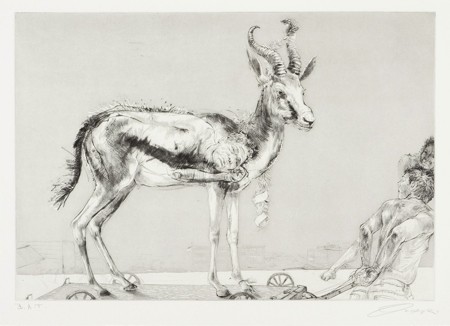Diane Victor
15 Apr - 22 May 2010
DIANE VICTOR
"Transcend"
Johannesburg Gallery: 15 April - 22 May 2010
Goodman Gallery is pleased to host Transcend, an exhibition of new drawings, lithographs, and etchings by Diane Victor. The works presented in this exhibition convey a strong sense of moving on, crossing boundaries, and leaving behind old ideas. The visual language is familiar but the works offer new interpretations of well-tried themes. Transcend signals a vital infusion of energy into the work of an already accomplished artist.
The exhibition includes several long-awaited additions to Victor’s ongoing series Disasters of Peace. These searing etchings continue Victor’s commentary on society and its ills but introduce new imagery and concerns: horses as symbols of potency and spirituality figure strongly. They are powerful, charging creatures, carrying unusual passengers. Their presence in the works suggests a fresh symbolic approach from Victor, though not without her signature absurdist humour.
Also included are two groups of new drawings. The first series continues Victor’s acute observations of the human body. The frank renditions of human subjects show us the body as a document, a record of actions and the effects of time on flesh. For these, Victor uses a powdered mixture of ash and charcoal to create a delicate surface on paper. The ash is the residue of burned willow wood and copies of old books like War and Peace, Ulysses, and Great Expectations, so that Victor’s method is a literal reconstitution of histories. She has used stencils and fixatives to make new narratives out of old, combining the unpredictability of dust with careful technical control of the material. The words ashes to ashes and dust to dust come to mind and are given substance in this treatment of loss and decay.
The second major new series, Birth of a Nation, is drawn from Victor’s studies of classical works made while travelling in Europe. The series takes a familiar set of classical stories and superimposes on them African and South African themes and landscapes. The abduction of Europa, for example, is transposed into a story about the ravaging of African fauna and flora. Here, Zeus the bull is a rhino, and rather than carrying Europa off to rape her, he is prone beneath a prosaic huntress whose AK-47 leans against his flank. The story of Leda and the swan becomes a violent encounter between a semi-autobiographical female figure and a white-backed vulture – not unlike the stork who menaces the infant Ganymede (in a visual pun on the story of the stork who delivers the baby).
In Transcend, Diane Victor shows once again that her rigorous processes are directly linked to the themes and concerns she explores. These new works demonstrate an extraordinary control of materials and subjects but also show that Victor is willing to work in new mediums. Her characteristic confrontational style is given new weight with the allusions to mythology and the introduction of a host of powerfully symbolic figures
"Transcend"
Johannesburg Gallery: 15 April - 22 May 2010
Goodman Gallery is pleased to host Transcend, an exhibition of new drawings, lithographs, and etchings by Diane Victor. The works presented in this exhibition convey a strong sense of moving on, crossing boundaries, and leaving behind old ideas. The visual language is familiar but the works offer new interpretations of well-tried themes. Transcend signals a vital infusion of energy into the work of an already accomplished artist.
The exhibition includes several long-awaited additions to Victor’s ongoing series Disasters of Peace. These searing etchings continue Victor’s commentary on society and its ills but introduce new imagery and concerns: horses as symbols of potency and spirituality figure strongly. They are powerful, charging creatures, carrying unusual passengers. Their presence in the works suggests a fresh symbolic approach from Victor, though not without her signature absurdist humour.
Also included are two groups of new drawings. The first series continues Victor’s acute observations of the human body. The frank renditions of human subjects show us the body as a document, a record of actions and the effects of time on flesh. For these, Victor uses a powdered mixture of ash and charcoal to create a delicate surface on paper. The ash is the residue of burned willow wood and copies of old books like War and Peace, Ulysses, and Great Expectations, so that Victor’s method is a literal reconstitution of histories. She has used stencils and fixatives to make new narratives out of old, combining the unpredictability of dust with careful technical control of the material. The words ashes to ashes and dust to dust come to mind and are given substance in this treatment of loss and decay.
The second major new series, Birth of a Nation, is drawn from Victor’s studies of classical works made while travelling in Europe. The series takes a familiar set of classical stories and superimposes on them African and South African themes and landscapes. The abduction of Europa, for example, is transposed into a story about the ravaging of African fauna and flora. Here, Zeus the bull is a rhino, and rather than carrying Europa off to rape her, he is prone beneath a prosaic huntress whose AK-47 leans against his flank. The story of Leda and the swan becomes a violent encounter between a semi-autobiographical female figure and a white-backed vulture – not unlike the stork who menaces the infant Ganymede (in a visual pun on the story of the stork who delivers the baby).
In Transcend, Diane Victor shows once again that her rigorous processes are directly linked to the themes and concerns she explores. These new works demonstrate an extraordinary control of materials and subjects but also show that Victor is willing to work in new mediums. Her characteristic confrontational style is given new weight with the allusions to mythology and the introduction of a host of powerfully symbolic figures

